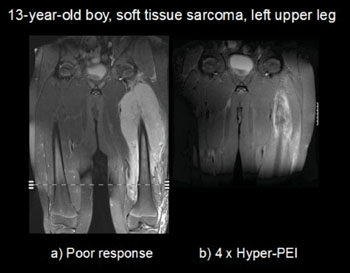Regional Deep Hyperthermia Treats Malignant Tumors
By HospiMedica International staff writers
Posted on 19 Mar 2014
A combination of multimodality therapy with regional hyperthermia improves the long-term survival of children with high-risk tumors with dismal prognosis. Posted on 19 Mar 2014
Developed by researchers at Heinrich-Heine-University (Düsseldorf, Germany), The Hyper-PEI protocol is designed for children and adolescents who suffer from nonresponding, unresectable or recurrent malignant tumor (without distant metastases), and involves cisplatin, etoposide, ifosfamide (PEI) chemotherapy concomitant with regional deep hyperthermia. Patients receive three to four treatment courses at 21-day intervals until residual tumor resection is possible; one or two additional courses of PEI-regional deep hyperthermia are then delivered, and local radiotherapy is given for incompletely resected tumors.

Image: Undifferentiated soft tissue sarcoma of the left upper leg in a 13-year old boy. On the left, insufficient tumor response after standard chemotherapy therapy. On the right, follow-up after four thermochemotherapy courses according to the Hyper-PEI protocol. The residual tumor mass could be completely resected without mutilation. (Photo courtesy of Heinrich-Heine-University)
To apply regional deep hyperthermia to children and adolescents with different body dimensions, electromagnetic heat applicators, comprised of 8–24 bipolar antennae are arranged equidistantly inside a lucite cylinder, producing temperatures of 41–43 °C. The temperatures are measured at fixed points, including the bladder, various critical skin areas, in the tumor, and in the surrounding normal tissue, using an automatic mapping system. To further control the locoregional application of hyperthermia in abdominal tumors, a noninvasive approach using magnetic resonance imaging (MRI) is used to define a patient specific 3-D temperature profile in the tumor or surrounding tissue.
Monitoring the tumor temperature noninvasively by MRI during hyperthermia is considered a major breakthrough, as it provides three dimensional (3-D) information on the temperature distribution in nearly the complete pelvic or abdomen volume, and enables direct feedback control of the power input settings if the measured tumor temperature is unsatisfactory, or if too high temperatures are observed in normal tissue.
“Recently, we reported the long-term results of a salvage Hyper-PEI protocol for pediatric patients with refractory or recurrent malignant germ-cell tumors; this protocol allows clinicians to provide a long-term cure for most of these patients with poor prognosis,” said protocol developer Ruediger Wessalowski, MD, PhD, of the clinic of pediatric oncology, hematology, and clinical immunology. “Multiple channel heat applicators and noninvasive MR temperature monitoring for childhood cancer can produce precise target volumes with substantial sparing of normal tissue.”
Related Links:
Heinrich-Heine-University














